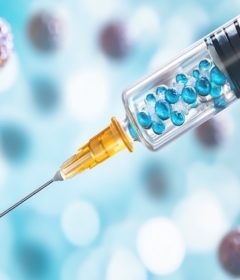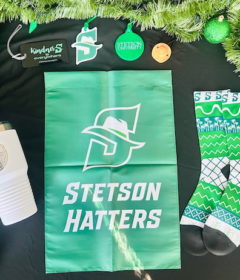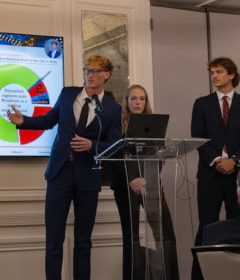Stetson Receives $547,875 Research Grant from the National Institutes of Health
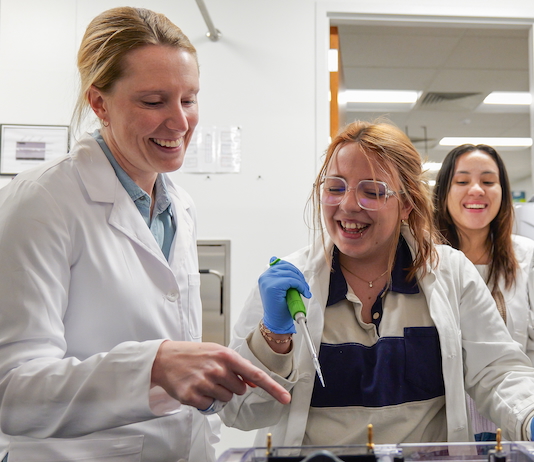
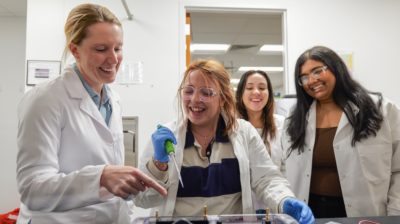
Assistant Professor Kristine Dye, PhD, isn’t new to innovative biomedical research or national research grants. Yet, the latest federal grant she has helped shepherd is especially rewarding. In early October, Stetson and Dye were granted $547,875 following her first Research Enhancement Awards proposal to the National Institutes of Health. The accomplishment is considered rare for a first-time effort, especially at a time when government funding for such grants is limited.
Research Enhancement Awards, dubbed R15, support research projects at educational institutions that provide baccalaureate or advanced degrees for a significant number of the nation’s research scientists but that have not been major recipients of NIH funding.
“It is nearly unheard of for an NIH grant to be awarded on the first attempt, but Dr. Dye worked diligently on her proposal and is very deserving of this grant award,” said Carol Buckels, director of Stetson’s Grants, Sponsored Research and Strategic Initiatives office. Like Dye, Stetson faculty members applying to NIH or other grant agencies are not on their own in their proposal development, Buckels added. The Grants Office and the McAllister & Quinn (M&Q) national grant consulting group both provide support.
In particular, the awards are intended to support meritorious research, expose students to research and strengthen the research environment of the institution.
Notably, in September, Dye was part of a Stetson team that received a $2 million award from the National Science Foundation to benefit scholars of science and related fields. In recent years, Dye has led students in the exploration of viruses responsible for cancer and infectious diseases, such as Merkel Cell Carcinoma and COVID-19, respectively, in what’s known as the Dye Lab.
This latest award bolsters her efforts to continue high-impact biomedical research on campus among undergraduates, another rare occurrence nationwide.
Benefits of the R15 Award
Since Dye arrived at Stetson five years ago from the University of Washington and the Fred Hutch Cancer Research Center, she had been planning to attract a significant federally funded grant. The desire was not only to defray the various costs of research, but also to enhance the research culture at Stetson. The R15 award, she says, achieves both goals.
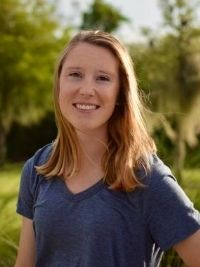
“The biggest thing that the award will fund are consumables. That means buying all the materials I need for the lab — from tissue culture dishes to grow our cells, enzymes to mutate DNA and the CO2 [carbon dioxide] to go in our incubators. Everything. And that amounts to thousands and thousands of dollars a year,” Dye said.
Dye also has four longtime undergraduate research assistants who will directly benefit. Recruited early at Stetson, each has worked with her for multiple years — devoting some 20 hours a week for no pay, including nights and weekends, and on top of classes, jobs, and athletics.
“I can now pay my research assistants, who had been volunteering, working with me for years in the lab,” Dye described. “They were all doing it volunteer previously because I didn’t have money to fund them. People always ask me, ‘How do you get them to volunteer?’ And I would answer, ‘They want to do it.’ Now, I can pay them!”
Ultimately, Dye added, the funding for students makes access to research projects more equitable — enabling students who must work to still participate. “Without pay, research experiences became inequitable. Students who had to work to feed themselves, pay housing and student loans didn’t have the time and ability to perform research on a volunteer basis,” Dye explained. “Paying research assistants allows me to kill two birds with one stone: help students financially while also strengthening their education and providing them with a job that will help them become more competitive in their future endeavors.”
In addition, the award brings dollars for travel to professional conferences, such as the ABRCMS (Annual Biomedical Research Conference for Minoritized Students) in San Antonio, Nov. 19-22. With expenses covered, Dye and the four research assistants are scheduled to attend. Further, there is funding for the publishing of students’ research articles in scientific journals, which come with a price.
The Biomedical Research
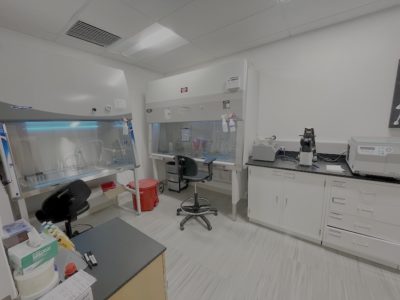
Currently, Dye and the students are studying viruses that cause cancer, specifically how Merkel Cell Polyomavirus (MCPyV) causes the skin cancer Merkel Cell Carcinoma (MCC). Approximately 20% of all cancers are caused by viruses, with MCPyV causing a cancer that is three times more deadly than melanoma, notes Dye. The virus was discovered in 2008, making it the most recently discovered virus that causes cancer in humans.
In essence, her research project is exploring how this particular virus — and the movement of a protein in the virus called the small tumor antigen — causes cancer, and what can be done to prevent it.
“This research could be really, really huge for the MCC field because right now only 50% of people respond to current therapies,” Dye said. “This research could potentially be on the road to creating novel efficacious therapies.”
The research by the four undergraduates is conducted at Sage Hall in Stetson’s Biosafety Level 2 laboratory, a facility designed to handle and contain microorganisms that pose a moderate risk of infection to laboratory workers and the environment.
Hatter Ready? Absolutely, yes, and more — taking the university’s initiative to deliver innovative, immersive, hands-on learning far beyond the norm. And, along with lessons about science, there is self-discovery.
The Student Researchers
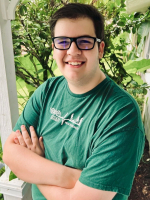
Jake Catha, a junior Molecular and Cell Biology major who hopes to pursue a doctorate degree, views the lab research as a “proving ground.”
“I get the opportunity to test my own abilities as a researcher and hone them to a greater degree,” Catha said. “It isn’t only valuable from the perspective of technical lab skills, but also in learning to seamlessly work with my peers on their own projects, learn to apply my logic and information to the overarching goals of the lab, and how to not only endure failure and struggle, but learn from it in a real, but understanding environment. … In short, it allows me to do real research that relies upon my own mind, but without tossing me straight into the deep end of the job.”
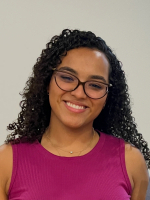
Junior Raissa Borges de Oliveira Leal, majoring in Chemistry and Economics, is planning to be a researcher focused on pressing health issues, such as understanding disease mechanisms and investigating therapies to address them.
“I believe that being a research assistant at the Dye Lab has made me a versatile scientist,” she said. “This is a foundational experience that is getting me ready for my PhD program.
“I’m learning about evolution and phylogenetic analysis through my project on the evolution of all known polyomaviruses, diving into cancer biology by investigating Merkel Cell Carcinoma, studying computational biology through our structural modeling experiments, and analyzing biochemical aspects with our mechanisms project.”
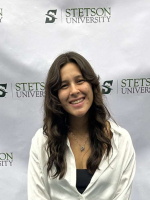
Noelle Zinn, a junior majoring in Biochemistry with a Health Sciences minor, wants to be a pediatric surgeon, perhaps with cardiothoracic and transplant specialties. She calls the research opportunity “incredible.”
“Professor Dye provides a high degree of autonomy to each student regarding their projects, by including guidance paired with discussion in our decision-making,” said Zinn, also a member of Stetson’s Women’s Rowing team. “Aside from formalities, our lab makes a wonderful family. By selecting likeminded, hardworking students, our lab has become filled with students of varying majors, cultures and strengths. Together, we create a family of friends that make long experiments fun the whole way through. Instead of just checking off a ‘research experience’ box on my resume, this lab has cultivated growth in several weak and strong areas of myself.”
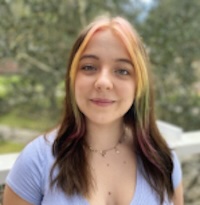
Junior Raven Hufstetler, a Biochemistry & Molecular Biology major, seeks to someday become a professor, a path that has been reaffirmed in the lab.
“My experience in the Dye Lab has provided a dynamic environment where I continuously refine my laboratory techniques and broaden my research expertise,” Hufstetler said. “The lab’s cyclic structure has also allowed me to mentor peers, strengthening my collaborative and leadership skills. This experience has not only deepened my love for scientific inquiry but also solidified my commitment to academia.
“This position [research assistant] has provided me with invaluable hands-on experience, allowing me to directly apply the concepts I learn in class to real-world challenges. It has also offered rare research opportunities that are often difficult to access at other universities.”
Indeed, those uncommon research experiences for undergraduates — perhaps even unparalleled — are exactly what Dye has wanted from her first day on campus. And they’re exactly what the NIH’s R15 award has afforded.
“I don’t think I ever saw an undergraduate lab doing this. … It’s not until you get up to graduate school that you do this level of research,” she said.
“It’s very rare in the undergraduate setting to be part of a research project where you are literally the one spearheading a rigorous research project with high-impact health implications. I think that is very, very unique.”
-Michael Candelaria

